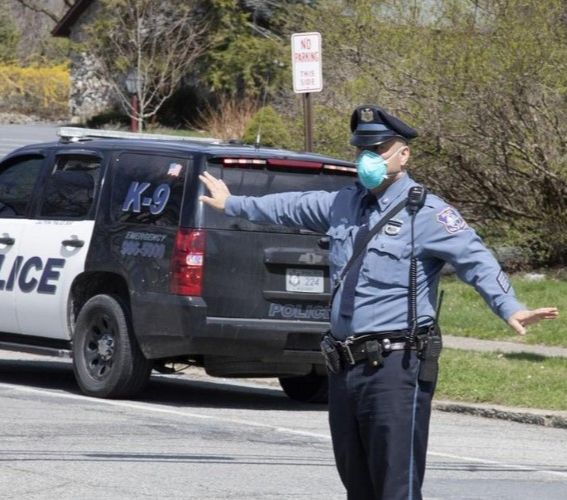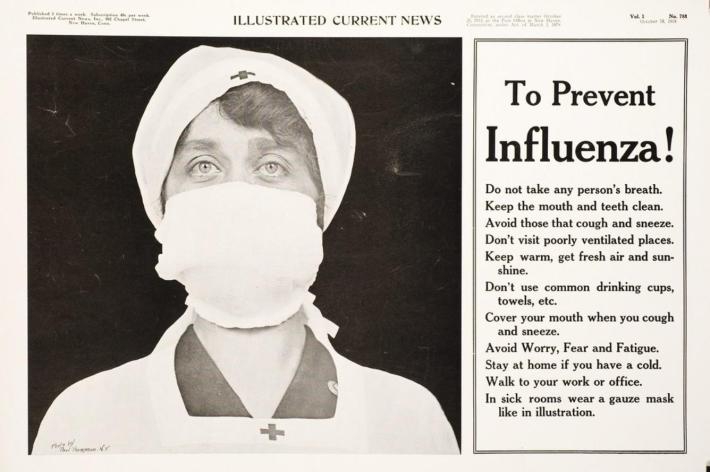Don’t Let Mask Laws Become Another Way We Over-Police Pedestrians

Source: Creative Commons.
Police are aggressively enforcing new social distancing and mask rules during the COVID-19 crisis — and it's already stirring up outrage about racial bias in enforcement, and the presence of law enforcement in public health efforts at all.
The most egregious examples are coming out of New York City, where newly minted social distancing policies have been enforced selectively, and with varying degrees of force — often depending on little more than the race of the "violator." Some stops have lead to viral videos of police violently wrestling pedestrians of color to the the sidewalk, while others have lead to nothing more than a gentle reminder to predominantly white New Yorkers keep six feet of distance during park picnics.
(Content warning: the videos below contain disturbing images of police violence.)
Police officers aggressively “enforcing” social distancing in our community.
— Hakeem Jeffries (@RepJeffries) May 5, 2020
This occurred in East New York last evening.
Why are sunbathers who violate social distancing guidelines treated one way and young men in certain communities another?
This MUST end. pic.twitter.com/aEU1H4bcdn
But New York is not the only city using the newly criminalized behaviors as occasion for troubling displays of force, incarceration and fines — particularly against people of color. In one particularly harsh Colorado county, violators of mask laws face up to 18 months in jail and a $5,000 penalty. In Philadelphia, a new mask policy on the city's transit network left scores of essential workers stranded, and lead to one person of color being violently removed from a bus.
Stories like this confirm the narrative of the destructive role police often play in public space — an all-too-familiar one in communities of color, where the systematic enforcement of pedestrian "crimes" reveal the structural and inherent biases of law enforcement. Those biases have long been hyper-visible, for instance, in the racial profiling practices that accompany Stop and Frisk policies, as well as in jaywalking laws that disproportionately impact people of color.
But COVID-19 laws aren't exactly the same as more long-standing pedestrian laws for one big reason: they actually save people's lives. Still, many advocates question whether enforcement is the best way to end the public health crisis — and what the public health risks of enforcement itself might be.
The troubled history of policing in pandemics
Of course, COVID-19 isn't the first pandemic America has faced – or the first time that police have gotten involved.
During the 1901 smallpox epidemic, public health was used as political cover to clear New York City's streets of widely maligned immigrant groups, whether or not they'd actually contracted the disease. City sanitation officials cleared tenements and the streets surrounding them, and any immigrants who showed signs of illness — smallpox or no — were shipped off to an island reachable only by boat. Many never returned.
"Manhattan sanitation superintendent Frederick Dillingham actually declared, 'No one knows the harm that has been done by these Italians,'" says Jennifer Wright, author of Get Well Soon, a cultural history of plagues. "It's very unfortunate that authorities have sometimes used pandemics as an excuse to crack down on vulnerable minorities."
There are more benign historical examples of policing of public health laws — the $1 fine for spitting during the 1918 influenza epidemic comes to mind — though Wright says even this lenient policy was rarely enforced. But generations of inequitable and even outright racist enforcement, both in and out of pandemics, have undoubtedly taken their toll on the public trust. One survey found that 54 percent of black Americans and 31 percent of Latinx Americans believe that the police "treat minorities more harshly as anyone else," compared to just 19 percent of white Americans.

"Policing comes with a lot of baggage for a lot of communities, especially those who have been the targets of racial disparities in enforcement and policy," said Alex Vitale, professor and author of The End of Policing. "Folks with more privilege, power and influence are not going to be subjected to the same level of police aggression as people without it, COVID-19 or no."
Even as pandemic laws rapidly evolve, that historical observation keeps proving true today. Pedestrians and transit users of color have already been subject to police brutality and harassment during COVID-19, both for failure to wear masks in business with mandatory mask policies (like this Pennsylvania man) and for refusing to remove masks in states that had not yet adopted those laws. (like these Illinois men.)
Most important, when the violators of the new COVID-19 laws are actually arrested and taken into custody, it does not actually stop the spread of COVID-19 — and if anything, such arrests might make matters worse. Officers who are not currently carriers are frequently made vulnerable to transmission in the process of the arrest itself, as evidenced by the high death count among law enforcement; violators enter often-crowded inmate populations, a group that's medically vulnerable, disproportionately infected, and dying in high numbers, too; both groups, eventually, have contact with others to whom they could spread a disease, whether they're going home to their families after their patrol shifts or after a (likely) short stay at the local jail.
'Are police even the right tool to solve this problem?'
As the horror stories continue, some advocates are questioning how we can work rapidly to get officers inherent bias training and decrease inequities in COVID-19 law enforcement. But others are wondering whether there's a more fundamental problem to solve: whether the police should be involved in public health at all.
"The solution is not to just get police to be nicer," said Vitale. "It’s to put better public health infrastructure in place. Anytime the police show up, we have to ask ourselves: what policy failure made this intervention necessary? In this case, it’s the fact that we haven’t created the kind of robust communication and resources we need."
The pandemic has spread so rapidly among communities of color primarily because of structural inequities in employment, healthcare access, environmental hazards, and more. But Vitale argues the government also failed to perform adequate non-police outreach to disenfranchised groups early in its rise — and then punished them with police brutality for not taking the word of government officials who they had good reason not to trust. Recruiting public health messengers who have real credibility in the communities they serve — Vitale gave school principals, or local faith leaders, or even artists who live in the neighborhood as examples — can be far more effective than police intervention and posturing, tough-on-crime press conferences.
"Right now, we have a public health system where people like President Trump and [New York] Gov. Cuomo and [New York] Mayor de Blasio give daily press conferences whose primary purpose is to shine up their images," said Vitale. "When Cuomo goes on TV and finger-wags about how we need more penalties for people who don’t follow mask policies, he’s not doing that because of public health; he’s doing that to make himself seem tough. If he really wanted to stop COVID-19, he'd be hiring thousands of public health messengers, just like he's hiring thousands of contact tracers right now."
Of course, making concrete resources available is crucial, too – and not just N95s. Finding adequate shelter for unhoused people who are being forced off of transit as a COVID-19 precaution is more important now than ever, as is strengthening every other element of our social safety net to make sure non-essential workers of color can afford to stay home and stay healthy.
It's a tall order — but until we do that, the very least we can do is exercise as much caution with our burgeoning mask laws as we do with our hand-washing routines. And maybe, we should consider whether mask and social distancing laws are really just a symptom of a bigger problem with how we're approaching public health — and who we're policing — on our streets.
Note: This piece was edited on 5/7/20 to provide additional clarity and context.
Kea Wilson has more than a dozen years experience as a writer telling emotional, urgent and actionable stories that motivate average Americans to get involved in making their cities better places. She is also a novelist, cyclist, and affordable housing advocate. She previously worked at Strong Towns, and currently lives in St. Louis, MO. Kea can be reached at kea@streetsblog.org or on Twitter @streetsblogkea. Please reach out to her with tips and submissions.
Read More:
Stay in touch
Sign up for our free newsletter
More from Streetsblog USA
How Car-Centric Cities Make Carrying For Families Stressful — Particularly For Women
Women do a disproportionate share of the care-related travel their households rely on — and car-focused planning isn't making matters easier.
Wednesday’s Headlines Build Green
A new bill dubbed "Build Green" would replace many of the climate-friendly elements Sen. Joe Manchin insisted on stripping from the Inflation Reduction Act.
E-Bikes and Creating Financially Sustainable Bike Share Programs
The number of customers using bike share in the U.S. and Canada is now at an all-time high thanks to e-bikes.
Tuesday’s Headlines Pick the Low-Hanging Fruit
Greg Shill argues that if a transformative road redesign isn't possible, it's time to talk about second-best strategies.
How to Fight a Texas-Sized Freeway Battle
A new book explores how Texas advocates are fighting back against destructive highway expansions. But what happened to those projects since it was sent to the printer?




